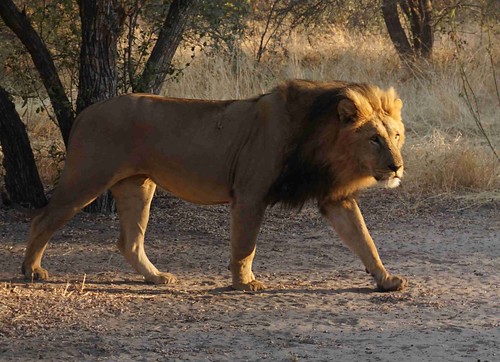
African lions are vulnerable to habitat fragmentation and U.S. Forest Service landscape modeling identified fencing and corridors as suitable solutions in many countries. Photo credit: Sam Cushman
The landscape modeling expertise Samuel Cushman provides as a research ecologist at the U.S. Forest Service’s Rocky Mountain Research Station is in demand worldwide as human-caused disturbances impact animal distribution, connectivity and survival.
Whether it’s clouded leopards in Borneo, lions in Africa, elephants in India, snow leopards in Central Asia or European brown bears, Cushman and his partners study what aspects of the landscape are truly important to animals, how they influence movement and genetic diversity, and which conservation plans will have the most impact.
“The importance of this work is to understand how to develop conservation management plans that are most effective for species and ecosystems. And that requires knowing what controls the distribution and connectivity of populations,” said Cushman.
In fact last year Cushman published a study in Landscape Ecology in which he, and his colleagues, modeled African lion movement in the Kavango-Zambezi Trans-frontier Conservation Area. They found that lions are vulnerable to habitat fragmentation and that strategically placed fencing and wildlife corridors may be a viable solution for lion conservation.
With the U.S. Forest Service’s additional collaborations in Borneo, Europe, India and Central Asia, the agency is on the cutting edge of international landscape modeling and conservation planning.
Over the last decade, the Forest Service developed this array of methods and models on U.S. national forest lands using bears and martens as their initial study animals. The first step in the modeling process requires researchers to collect genetic samples and place GPS trackers on animals.
Back in the lab, the genetic data provides researchers with information about how related animals are, and the GPS data allows for researchers to track how animals travel across a landscape.
Researchers can then identify what types of features (roadways, rivers, mountains, etc.) influence dispersal and population connectivity as well as what features are impassable barriers. When they pair the movement and genetic data together researchers can achieve a high level of confidence in linking the processes that govern movement to the population-level effects on gene flow and genetic diversity, which are crucial for maintaining healthy populations into the future.
The initial work on bears and martens in the U.S. evaluated the impact of overpass and highway construction in an effort to make them more animal friendly, while the African lion results and clouded leopard findings from Borneo are deeply embedded in new regional conservation planning processes. And with Cushman’s upcoming trip to India, and as other Forest Service researchers travel the globe on-demand to provide expertise, the wide applicability and impact of Forest Service research continues to grow.
No comments:
Post a Comment
Note: Only a member of this blog may post a comment.